An Ethical Dilemma: Rights of the Child in Early Childhood Education
VerifiedAdded on 2022/11/14
|10
|2795
|359
Essay
AI Summary
This essay presents an analysis of an ethical dilemma concerning a two-and-a-half-year-old child named Mayah who is consistently falling asleep in school after lunch. The parents, concerned about Mayah's sleep schedule at home, instructed the educator not to allow her to sleep. The educator, considering Mayah's age and the child's right to rest, permitted her to sleep, leading to a conflict when the parents found her asleep. The essay explores the rationale behind the educator's decision, emphasizing children's rights as outlined by ACECQA, NSW Legislation, and UNCRC. It examines the professional viewpoint, ethical principles (beneficence, justice, respect for autonomy), and ethical theories (utilitarianism, rights theory, deontology) applied in resolving the dilemma. The author concludes that educators of early childhood education are professionals and gifted people who are well equipped to balance fairness and justice, children's rights, and guiding regulations.
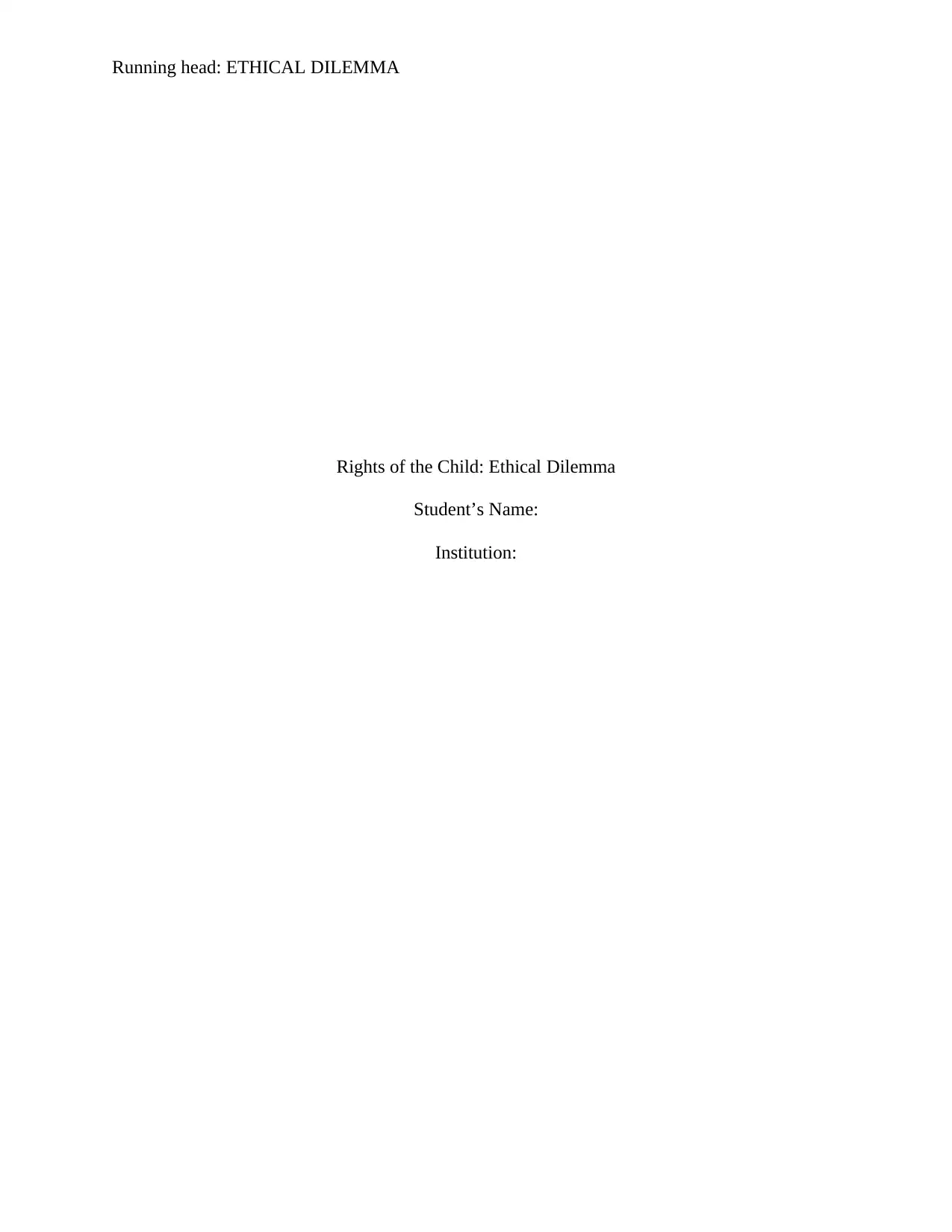
Running head: ETHICAL DILEMMA
Rights of the Child: Ethical Dilemma
Student’s Name:
Institution:
Rights of the Child: Ethical Dilemma
Student’s Name:
Institution:
Paraphrase This Document
Need a fresh take? Get an instant paraphrase of this document with our AI Paraphraser
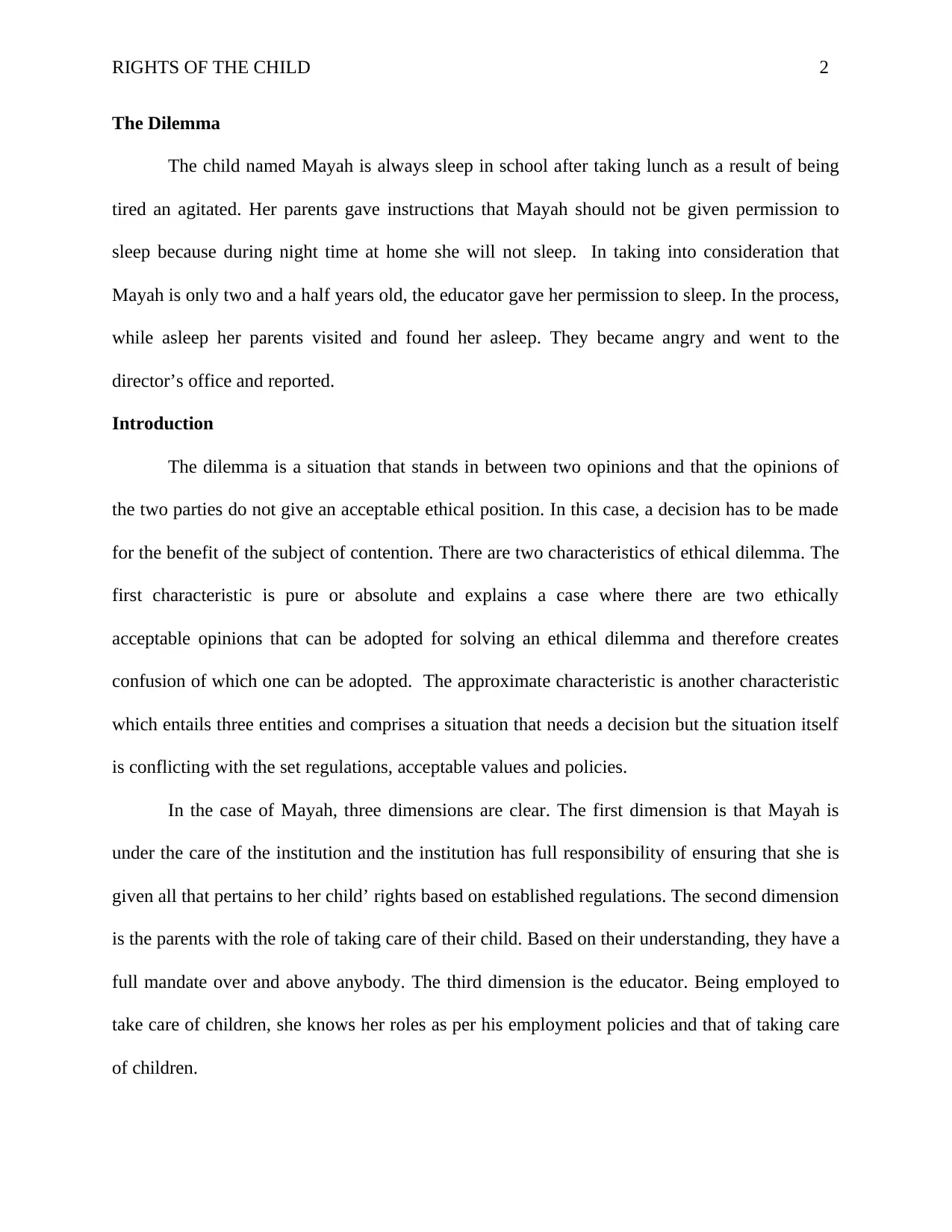
RIGHTS OF THE CHILD 2
The Dilemma
The child named Mayah is always sleep in school after taking lunch as a result of being
tired an agitated. Her parents gave instructions that Mayah should not be given permission to
sleep because during night time at home she will not sleep. In taking into consideration that
Mayah is only two and a half years old, the educator gave her permission to sleep. In the process,
while asleep her parents visited and found her asleep. They became angry and went to the
director’s office and reported.
Introduction
The dilemma is a situation that stands in between two opinions and that the opinions of
the two parties do not give an acceptable ethical position. In this case, a decision has to be made
for the benefit of the subject of contention. There are two characteristics of ethical dilemma. The
first characteristic is pure or absolute and explains a case where there are two ethically
acceptable opinions that can be adopted for solving an ethical dilemma and therefore creates
confusion of which one can be adopted. The approximate characteristic is another characteristic
which entails three entities and comprises a situation that needs a decision but the situation itself
is conflicting with the set regulations, acceptable values and policies.
In the case of Mayah, three dimensions are clear. The first dimension is that Mayah is
under the care of the institution and the institution has full responsibility of ensuring that she is
given all that pertains to her child’ rights based on established regulations. The second dimension
is the parents with the role of taking care of their child. Based on their understanding, they have a
full mandate over and above anybody. The third dimension is the educator. Being employed to
take care of children, she knows her roles as per his employment policies and that of taking care
of children.
The Dilemma
The child named Mayah is always sleep in school after taking lunch as a result of being
tired an agitated. Her parents gave instructions that Mayah should not be given permission to
sleep because during night time at home she will not sleep. In taking into consideration that
Mayah is only two and a half years old, the educator gave her permission to sleep. In the process,
while asleep her parents visited and found her asleep. They became angry and went to the
director’s office and reported.
Introduction
The dilemma is a situation that stands in between two opinions and that the opinions of
the two parties do not give an acceptable ethical position. In this case, a decision has to be made
for the benefit of the subject of contention. There are two characteristics of ethical dilemma. The
first characteristic is pure or absolute and explains a case where there are two ethically
acceptable opinions that can be adopted for solving an ethical dilemma and therefore creates
confusion of which one can be adopted. The approximate characteristic is another characteristic
which entails three entities and comprises a situation that needs a decision but the situation itself
is conflicting with the set regulations, acceptable values and policies.
In the case of Mayah, three dimensions are clear. The first dimension is that Mayah is
under the care of the institution and the institution has full responsibility of ensuring that she is
given all that pertains to her child’ rights based on established regulations. The second dimension
is the parents with the role of taking care of their child. Based on their understanding, they have a
full mandate over and above anybody. The third dimension is the educator. Being employed to
take care of children, she knows her roles as per his employment policies and that of taking care
of children.
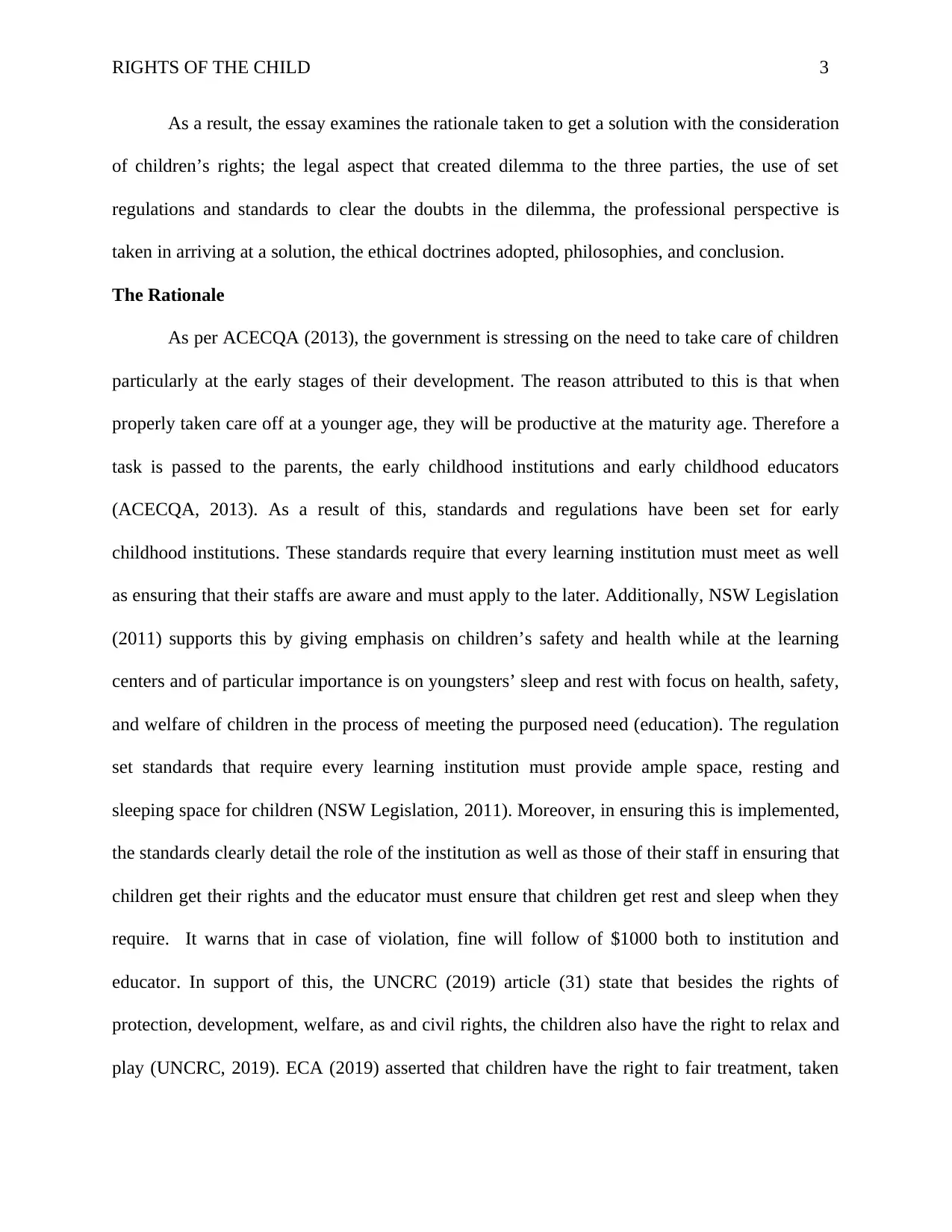
RIGHTS OF THE CHILD 3
As a result, the essay examines the rationale taken to get a solution with the consideration
of children’s rights; the legal aspect that created dilemma to the three parties, the use of set
regulations and standards to clear the doubts in the dilemma, the professional perspective is
taken in arriving at a solution, the ethical doctrines adopted, philosophies, and conclusion.
The Rationale
As per ACECQA (2013), the government is stressing on the need to take care of children
particularly at the early stages of their development. The reason attributed to this is that when
properly taken care off at a younger age, they will be productive at the maturity age. Therefore a
task is passed to the parents, the early childhood institutions and early childhood educators
(ACECQA, 2013). As a result of this, standards and regulations have been set for early
childhood institutions. These standards require that every learning institution must meet as well
as ensuring that their staffs are aware and must apply to the later. Additionally, NSW Legislation
(2011) supports this by giving emphasis on children’s safety and health while at the learning
centers and of particular importance is on youngsters’ sleep and rest with focus on health, safety,
and welfare of children in the process of meeting the purposed need (education). The regulation
set standards that require every learning institution must provide ample space, resting and
sleeping space for children (NSW Legislation, 2011). Moreover, in ensuring this is implemented,
the standards clearly detail the role of the institution as well as those of their staff in ensuring that
children get their rights and the educator must ensure that children get rest and sleep when they
require. It warns that in case of violation, fine will follow of $1000 both to institution and
educator. In support of this, the UNCRC (2019) article (31) state that besides the rights of
protection, development, welfare, as and civil rights, the children also have the right to relax and
play (UNCRC, 2019). ECA (2019) asserted that children have the right to fair treatment, taken
As a result, the essay examines the rationale taken to get a solution with the consideration
of children’s rights; the legal aspect that created dilemma to the three parties, the use of set
regulations and standards to clear the doubts in the dilemma, the professional perspective is
taken in arriving at a solution, the ethical doctrines adopted, philosophies, and conclusion.
The Rationale
As per ACECQA (2013), the government is stressing on the need to take care of children
particularly at the early stages of their development. The reason attributed to this is that when
properly taken care off at a younger age, they will be productive at the maturity age. Therefore a
task is passed to the parents, the early childhood institutions and early childhood educators
(ACECQA, 2013). As a result of this, standards and regulations have been set for early
childhood institutions. These standards require that every learning institution must meet as well
as ensuring that their staffs are aware and must apply to the later. Additionally, NSW Legislation
(2011) supports this by giving emphasis on children’s safety and health while at the learning
centers and of particular importance is on youngsters’ sleep and rest with focus on health, safety,
and welfare of children in the process of meeting the purposed need (education). The regulation
set standards that require every learning institution must provide ample space, resting and
sleeping space for children (NSW Legislation, 2011). Moreover, in ensuring this is implemented,
the standards clearly detail the role of the institution as well as those of their staff in ensuring that
children get their rights and the educator must ensure that children get rest and sleep when they
require. It warns that in case of violation, fine will follow of $1000 both to institution and
educator. In support of this, the UNCRC (2019) article (31) state that besides the rights of
protection, development, welfare, as and civil rights, the children also have the right to relax and
play (UNCRC, 2019). ECA (2019) asserted that children have the right to fair treatment, taken
⊘ This is a preview!⊘
Do you want full access?
Subscribe today to unlock all pages.

Trusted by 1+ million students worldwide
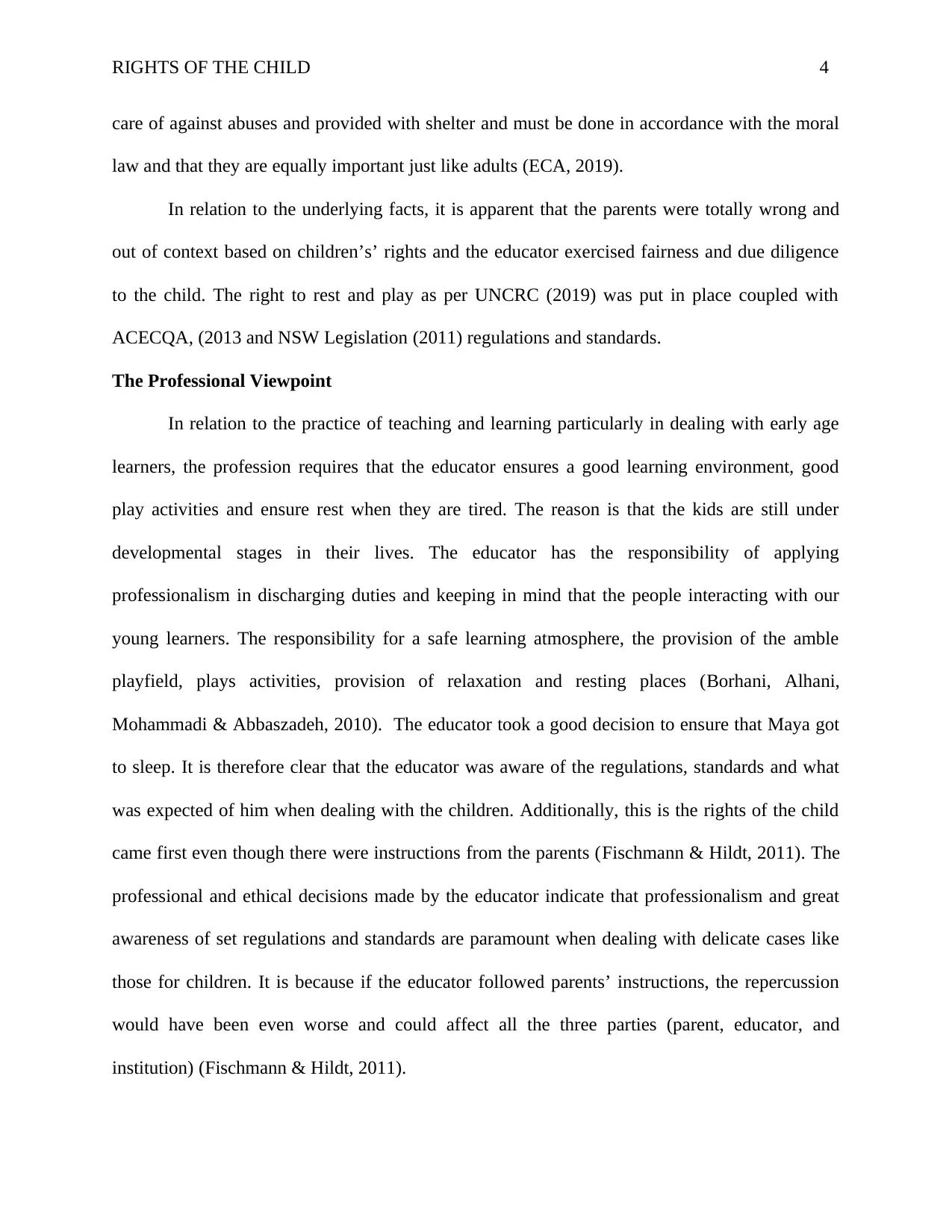
RIGHTS OF THE CHILD 4
care of against abuses and provided with shelter and must be done in accordance with the moral
law and that they are equally important just like adults (ECA, 2019).
In relation to the underlying facts, it is apparent that the parents were totally wrong and
out of context based on children’s’ rights and the educator exercised fairness and due diligence
to the child. The right to rest and play as per UNCRC (2019) was put in place coupled with
ACECQA, (2013 and NSW Legislation (2011) regulations and standards.
The Professional Viewpoint
In relation to the practice of teaching and learning particularly in dealing with early age
learners, the profession requires that the educator ensures a good learning environment, good
play activities and ensure rest when they are tired. The reason is that the kids are still under
developmental stages in their lives. The educator has the responsibility of applying
professionalism in discharging duties and keeping in mind that the people interacting with our
young learners. The responsibility for a safe learning atmosphere, the provision of the amble
playfield, plays activities, provision of relaxation and resting places (Borhani, Alhani,
Mohammadi & Abbaszadeh, 2010). The educator took a good decision to ensure that Maya got
to sleep. It is therefore clear that the educator was aware of the regulations, standards and what
was expected of him when dealing with the children. Additionally, this is the rights of the child
came first even though there were instructions from the parents (Fischmann & Hildt, 2011). The
professional and ethical decisions made by the educator indicate that professionalism and great
awareness of set regulations and standards are paramount when dealing with delicate cases like
those for children. It is because if the educator followed parents’ instructions, the repercussion
would have been even worse and could affect all the three parties (parent, educator, and
institution) (Fischmann & Hildt, 2011).
care of against abuses and provided with shelter and must be done in accordance with the moral
law and that they are equally important just like adults (ECA, 2019).
In relation to the underlying facts, it is apparent that the parents were totally wrong and
out of context based on children’s’ rights and the educator exercised fairness and due diligence
to the child. The right to rest and play as per UNCRC (2019) was put in place coupled with
ACECQA, (2013 and NSW Legislation (2011) regulations and standards.
The Professional Viewpoint
In relation to the practice of teaching and learning particularly in dealing with early age
learners, the profession requires that the educator ensures a good learning environment, good
play activities and ensure rest when they are tired. The reason is that the kids are still under
developmental stages in their lives. The educator has the responsibility of applying
professionalism in discharging duties and keeping in mind that the people interacting with our
young learners. The responsibility for a safe learning atmosphere, the provision of the amble
playfield, plays activities, provision of relaxation and resting places (Borhani, Alhani,
Mohammadi & Abbaszadeh, 2010). The educator took a good decision to ensure that Maya got
to sleep. It is therefore clear that the educator was aware of the regulations, standards and what
was expected of him when dealing with the children. Additionally, this is the rights of the child
came first even though there were instructions from the parents (Fischmann & Hildt, 2011). The
professional and ethical decisions made by the educator indicate that professionalism and great
awareness of set regulations and standards are paramount when dealing with delicate cases like
those for children. It is because if the educator followed parents’ instructions, the repercussion
would have been even worse and could affect all the three parties (parent, educator, and
institution) (Fischmann & Hildt, 2011).
Paraphrase This Document
Need a fresh take? Get an instant paraphrase of this document with our AI Paraphraser
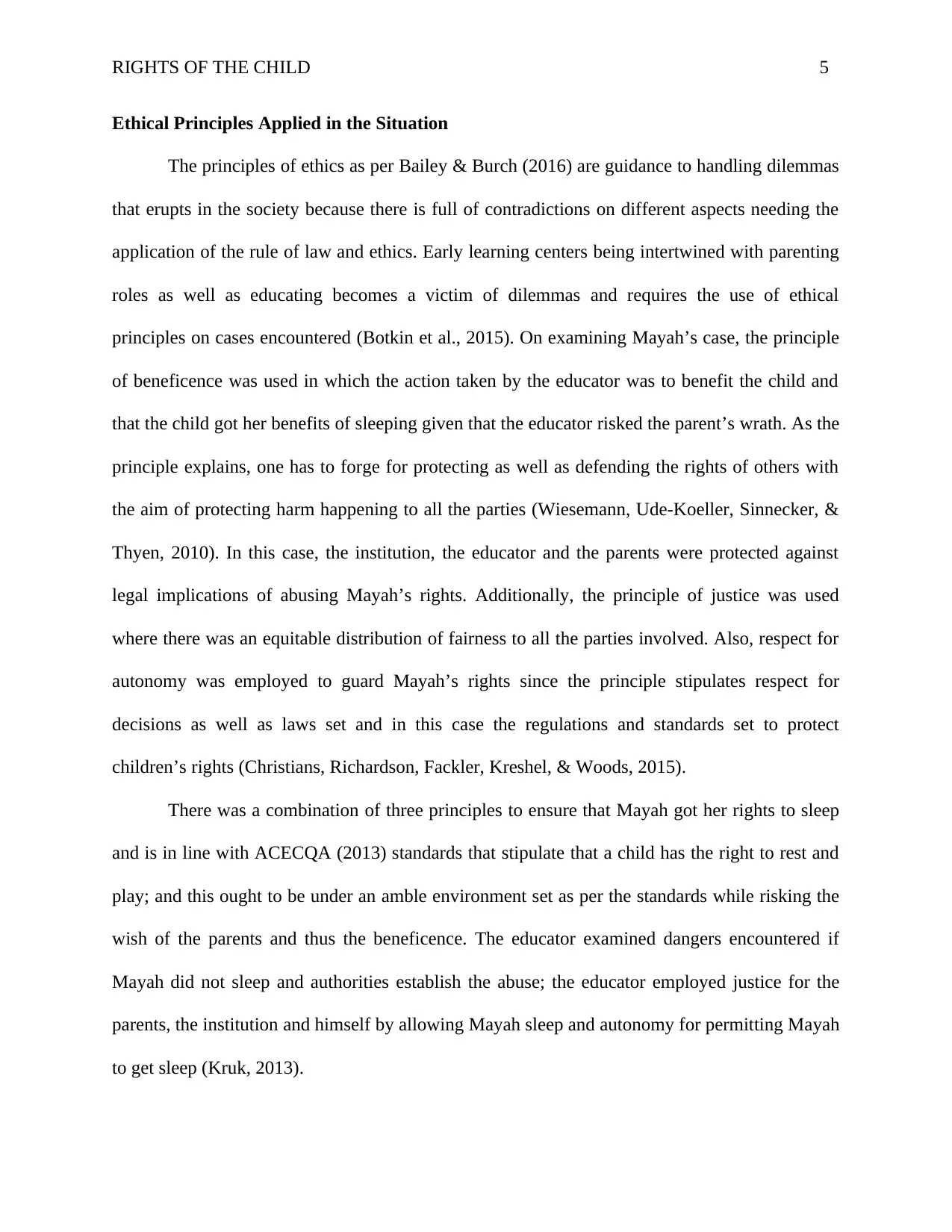
RIGHTS OF THE CHILD 5
Ethical Principles Applied in the Situation
The principles of ethics as per Bailey & Burch (2016) are guidance to handling dilemmas
that erupts in the society because there is full of contradictions on different aspects needing the
application of the rule of law and ethics. Early learning centers being intertwined with parenting
roles as well as educating becomes a victim of dilemmas and requires the use of ethical
principles on cases encountered (Botkin et al., 2015). On examining Mayah’s case, the principle
of beneficence was used in which the action taken by the educator was to benefit the child and
that the child got her benefits of sleeping given that the educator risked the parent’s wrath. As the
principle explains, one has to forge for protecting as well as defending the rights of others with
the aim of protecting harm happening to all the parties (Wiesemann, Ude-Koeller, Sinnecker, &
Thyen, 2010). In this case, the institution, the educator and the parents were protected against
legal implications of abusing Mayah’s rights. Additionally, the principle of justice was used
where there was an equitable distribution of fairness to all the parties involved. Also, respect for
autonomy was employed to guard Mayah’s rights since the principle stipulates respect for
decisions as well as laws set and in this case the regulations and standards set to protect
children’s rights (Christians, Richardson, Fackler, Kreshel, & Woods, 2015).
There was a combination of three principles to ensure that Mayah got her rights to sleep
and is in line with ACECQA (2013) standards that stipulate that a child has the right to rest and
play; and this ought to be under an amble environment set as per the standards while risking the
wish of the parents and thus the beneficence. The educator examined dangers encountered if
Mayah did not sleep and authorities establish the abuse; the educator employed justice for the
parents, the institution and himself by allowing Mayah sleep and autonomy for permitting Mayah
to get sleep (Kruk, 2013).
Ethical Principles Applied in the Situation
The principles of ethics as per Bailey & Burch (2016) are guidance to handling dilemmas
that erupts in the society because there is full of contradictions on different aspects needing the
application of the rule of law and ethics. Early learning centers being intertwined with parenting
roles as well as educating becomes a victim of dilemmas and requires the use of ethical
principles on cases encountered (Botkin et al., 2015). On examining Mayah’s case, the principle
of beneficence was used in which the action taken by the educator was to benefit the child and
that the child got her benefits of sleeping given that the educator risked the parent’s wrath. As the
principle explains, one has to forge for protecting as well as defending the rights of others with
the aim of protecting harm happening to all the parties (Wiesemann, Ude-Koeller, Sinnecker, &
Thyen, 2010). In this case, the institution, the educator and the parents were protected against
legal implications of abusing Mayah’s rights. Additionally, the principle of justice was used
where there was an equitable distribution of fairness to all the parties involved. Also, respect for
autonomy was employed to guard Mayah’s rights since the principle stipulates respect for
decisions as well as laws set and in this case the regulations and standards set to protect
children’s rights (Christians, Richardson, Fackler, Kreshel, & Woods, 2015).
There was a combination of three principles to ensure that Mayah got her rights to sleep
and is in line with ACECQA (2013) standards that stipulate that a child has the right to rest and
play; and this ought to be under an amble environment set as per the standards while risking the
wish of the parents and thus the beneficence. The educator examined dangers encountered if
Mayah did not sleep and authorities establish the abuse; the educator employed justice for the
parents, the institution and himself by allowing Mayah sleep and autonomy for permitting Mayah
to get sleep (Kruk, 2013).
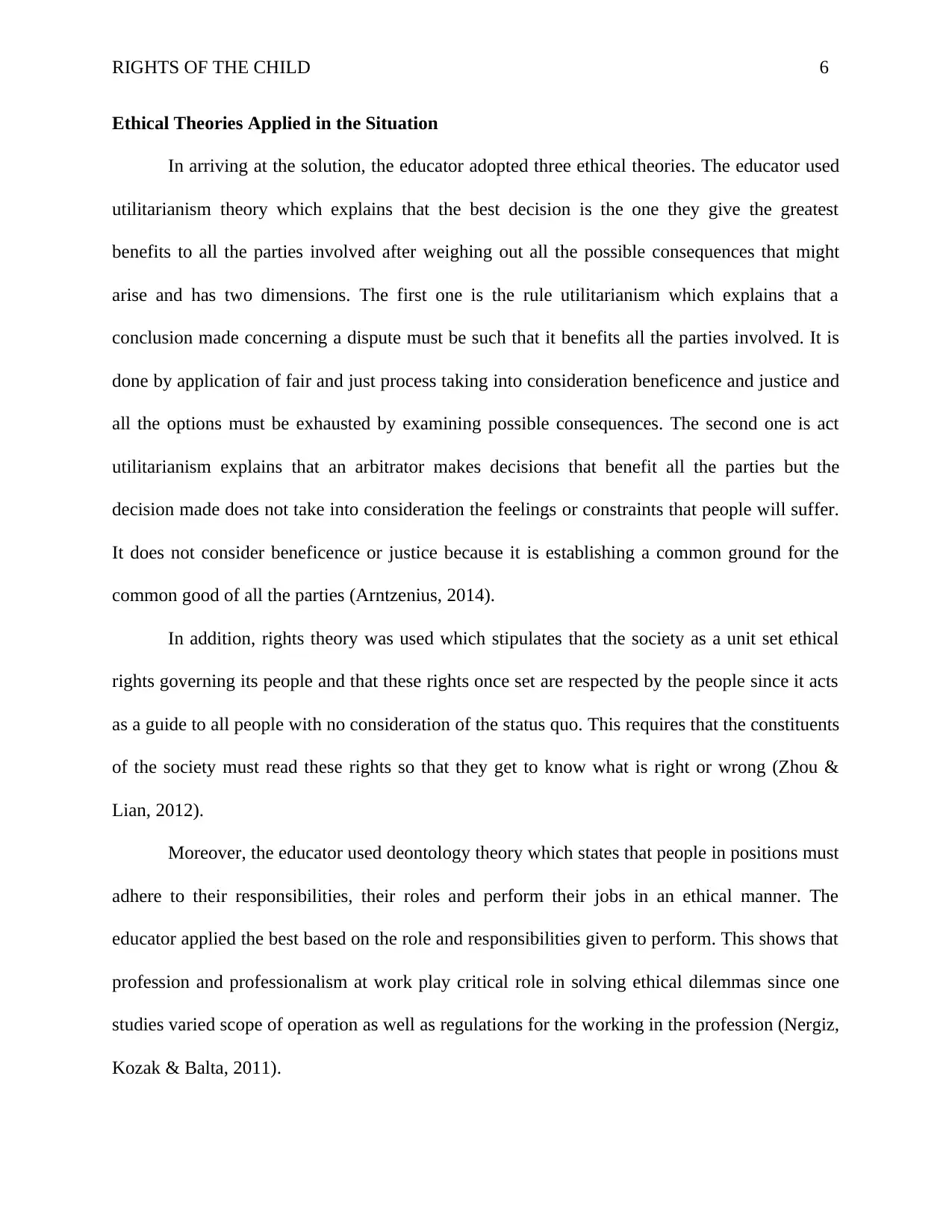
RIGHTS OF THE CHILD 6
Ethical Theories Applied in the Situation
In arriving at the solution, the educator adopted three ethical theories. The educator used
utilitarianism theory which explains that the best decision is the one they give the greatest
benefits to all the parties involved after weighing out all the possible consequences that might
arise and has two dimensions. The first one is the rule utilitarianism which explains that a
conclusion made concerning a dispute must be such that it benefits all the parties involved. It is
done by application of fair and just process taking into consideration beneficence and justice and
all the options must be exhausted by examining possible consequences. The second one is act
utilitarianism explains that an arbitrator makes decisions that benefit all the parties but the
decision made does not take into consideration the feelings or constraints that people will suffer.
It does not consider beneficence or justice because it is establishing a common ground for the
common good of all the parties (Arntzenius, 2014).
In addition, rights theory was used which stipulates that the society as a unit set ethical
rights governing its people and that these rights once set are respected by the people since it acts
as a guide to all people with no consideration of the status quo. This requires that the constituents
of the society must read these rights so that they get to know what is right or wrong (Zhou &
Lian, 2012).
Moreover, the educator used deontology theory which states that people in positions must
adhere to their responsibilities, their roles and perform their jobs in an ethical manner. The
educator applied the best based on the role and responsibilities given to perform. This shows that
profession and professionalism at work play critical role in solving ethical dilemmas since one
studies varied scope of operation as well as regulations for the working in the profession (Nergiz,
Kozak & Balta, 2011).
Ethical Theories Applied in the Situation
In arriving at the solution, the educator adopted three ethical theories. The educator used
utilitarianism theory which explains that the best decision is the one they give the greatest
benefits to all the parties involved after weighing out all the possible consequences that might
arise and has two dimensions. The first one is the rule utilitarianism which explains that a
conclusion made concerning a dispute must be such that it benefits all the parties involved. It is
done by application of fair and just process taking into consideration beneficence and justice and
all the options must be exhausted by examining possible consequences. The second one is act
utilitarianism explains that an arbitrator makes decisions that benefit all the parties but the
decision made does not take into consideration the feelings or constraints that people will suffer.
It does not consider beneficence or justice because it is establishing a common ground for the
common good of all the parties (Arntzenius, 2014).
In addition, rights theory was used which stipulates that the society as a unit set ethical
rights governing its people and that these rights once set are respected by the people since it acts
as a guide to all people with no consideration of the status quo. This requires that the constituents
of the society must read these rights so that they get to know what is right or wrong (Zhou &
Lian, 2012).
Moreover, the educator used deontology theory which states that people in positions must
adhere to their responsibilities, their roles and perform their jobs in an ethical manner. The
educator applied the best based on the role and responsibilities given to perform. This shows that
profession and professionalism at work play critical role in solving ethical dilemmas since one
studies varied scope of operation as well as regulations for the working in the profession (Nergiz,
Kozak & Balta, 2011).
⊘ This is a preview!⊘
Do you want full access?
Subscribe today to unlock all pages.

Trusted by 1+ million students worldwide
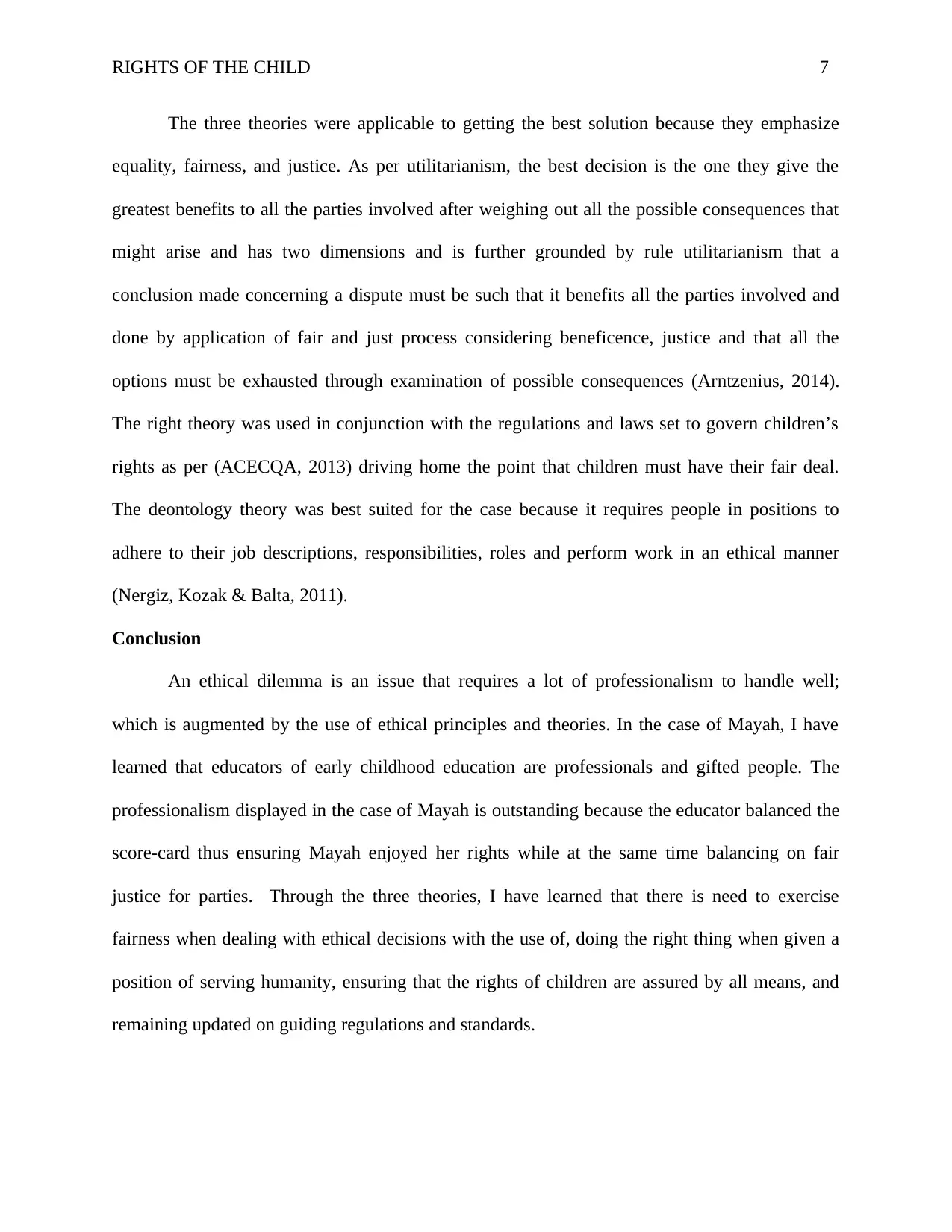
RIGHTS OF THE CHILD 7
The three theories were applicable to getting the best solution because they emphasize
equality, fairness, and justice. As per utilitarianism, the best decision is the one they give the
greatest benefits to all the parties involved after weighing out all the possible consequences that
might arise and has two dimensions and is further grounded by rule utilitarianism that a
conclusion made concerning a dispute must be such that it benefits all the parties involved and
done by application of fair and just process considering beneficence, justice and that all the
options must be exhausted through examination of possible consequences (Arntzenius, 2014).
The right theory was used in conjunction with the regulations and laws set to govern children’s
rights as per (ACECQA, 2013) driving home the point that children must have their fair deal.
The deontology theory was best suited for the case because it requires people in positions to
adhere to their job descriptions, responsibilities, roles and perform work in an ethical manner
(Nergiz, Kozak & Balta, 2011).
Conclusion
An ethical dilemma is an issue that requires a lot of professionalism to handle well;
which is augmented by the use of ethical principles and theories. In the case of Mayah, I have
learned that educators of early childhood education are professionals and gifted people. The
professionalism displayed in the case of Mayah is outstanding because the educator balanced the
score-card thus ensuring Mayah enjoyed her rights while at the same time balancing on fair
justice for parties. Through the three theories, I have learned that there is need to exercise
fairness when dealing with ethical decisions with the use of, doing the right thing when given a
position of serving humanity, ensuring that the rights of children are assured by all means, and
remaining updated on guiding regulations and standards.
The three theories were applicable to getting the best solution because they emphasize
equality, fairness, and justice. As per utilitarianism, the best decision is the one they give the
greatest benefits to all the parties involved after weighing out all the possible consequences that
might arise and has two dimensions and is further grounded by rule utilitarianism that a
conclusion made concerning a dispute must be such that it benefits all the parties involved and
done by application of fair and just process considering beneficence, justice and that all the
options must be exhausted through examination of possible consequences (Arntzenius, 2014).
The right theory was used in conjunction with the regulations and laws set to govern children’s
rights as per (ACECQA, 2013) driving home the point that children must have their fair deal.
The deontology theory was best suited for the case because it requires people in positions to
adhere to their job descriptions, responsibilities, roles and perform work in an ethical manner
(Nergiz, Kozak & Balta, 2011).
Conclusion
An ethical dilemma is an issue that requires a lot of professionalism to handle well;
which is augmented by the use of ethical principles and theories. In the case of Mayah, I have
learned that educators of early childhood education are professionals and gifted people. The
professionalism displayed in the case of Mayah is outstanding because the educator balanced the
score-card thus ensuring Mayah enjoyed her rights while at the same time balancing on fair
justice for parties. Through the three theories, I have learned that there is need to exercise
fairness when dealing with ethical decisions with the use of, doing the right thing when given a
position of serving humanity, ensuring that the rights of children are assured by all means, and
remaining updated on guiding regulations and standards.
Paraphrase This Document
Need a fresh take? Get an instant paraphrase of this document with our AI Paraphraser
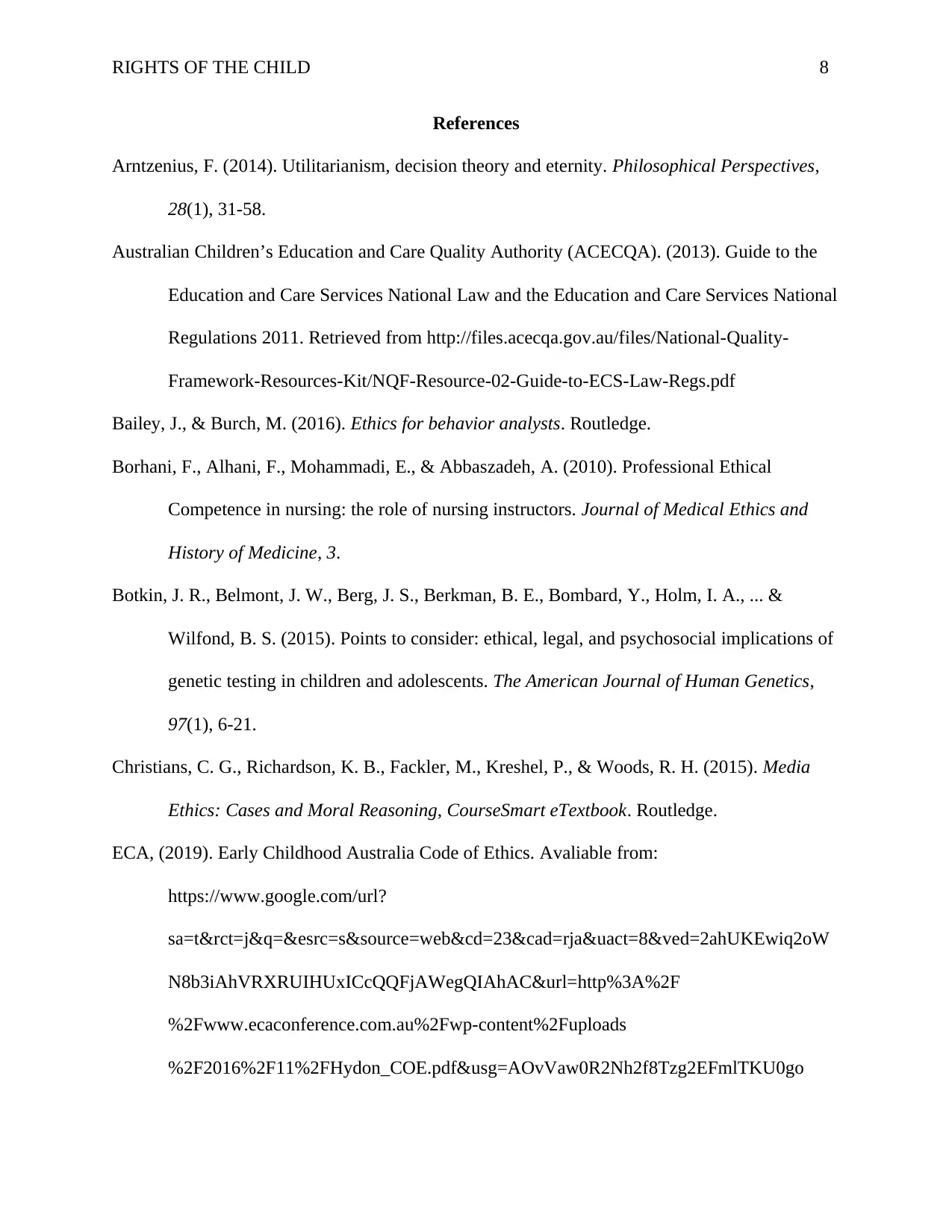
RIGHTS OF THE CHILD 8
References
Arntzenius, F. (2014). Utilitarianism, decision theory and eternity. Philosophical Perspectives,
28(1), 31-58.
Australian Children’s Education and Care Quality Authority (ACECQA). (2013). Guide to the
Education and Care Services National Law and the Education and Care Services National
Regulations 2011. Retrieved from http://files.acecqa.gov.au/files/National-Quality-
Framework-Resources-Kit/NQF-Resource-02-Guide-to-ECS-Law-Regs.pdf
Bailey, J., & Burch, M. (2016). Ethics for behavior analysts. Routledge.
Borhani, F., Alhani, F., Mohammadi, E., & Abbaszadeh, A. (2010). Professional Ethical
Competence in nursing: the role of nursing instructors. Journal of Medical Ethics and
History of Medicine, 3.
Botkin, J. R., Belmont, J. W., Berg, J. S., Berkman, B. E., Bombard, Y., Holm, I. A., ... &
Wilfond, B. S. (2015). Points to consider: ethical, legal, and psychosocial implications of
genetic testing in children and adolescents. The American Journal of Human Genetics,
97(1), 6-21.
Christians, C. G., Richardson, K. B., Fackler, M., Kreshel, P., & Woods, R. H. (2015). Media
Ethics: Cases and Moral Reasoning, CourseSmart eTextbook. Routledge.
ECA, (2019). Early Childhood Australia Code of Ethics. Avaliable from:
https://www.google.com/url?
sa=t&rct=j&q=&esrc=s&source=web&cd=23&cad=rja&uact=8&ved=2ahUKEwiq2oW
N8b3iAhVRXRUIHUxICcQQFjAWegQIAhAC&url=http%3A%2F
%2Fwww.ecaconference.com.au%2Fwp-content%2Fuploads
%2F2016%2F11%2FHydon_COE.pdf&usg=AOvVaw0R2Nh2f8Tzg2EFmlTKU0go
References
Arntzenius, F. (2014). Utilitarianism, decision theory and eternity. Philosophical Perspectives,
28(1), 31-58.
Australian Children’s Education and Care Quality Authority (ACECQA). (2013). Guide to the
Education and Care Services National Law and the Education and Care Services National
Regulations 2011. Retrieved from http://files.acecqa.gov.au/files/National-Quality-
Framework-Resources-Kit/NQF-Resource-02-Guide-to-ECS-Law-Regs.pdf
Bailey, J., & Burch, M. (2016). Ethics for behavior analysts. Routledge.
Borhani, F., Alhani, F., Mohammadi, E., & Abbaszadeh, A. (2010). Professional Ethical
Competence in nursing: the role of nursing instructors. Journal of Medical Ethics and
History of Medicine, 3.
Botkin, J. R., Belmont, J. W., Berg, J. S., Berkman, B. E., Bombard, Y., Holm, I. A., ... &
Wilfond, B. S. (2015). Points to consider: ethical, legal, and psychosocial implications of
genetic testing in children and adolescents. The American Journal of Human Genetics,
97(1), 6-21.
Christians, C. G., Richardson, K. B., Fackler, M., Kreshel, P., & Woods, R. H. (2015). Media
Ethics: Cases and Moral Reasoning, CourseSmart eTextbook. Routledge.
ECA, (2019). Early Childhood Australia Code of Ethics. Avaliable from:
https://www.google.com/url?
sa=t&rct=j&q=&esrc=s&source=web&cd=23&cad=rja&uact=8&ved=2ahUKEwiq2oW
N8b3iAhVRXRUIHUxICcQQFjAWegQIAhAC&url=http%3A%2F
%2Fwww.ecaconference.com.au%2Fwp-content%2Fuploads
%2F2016%2F11%2FHydon_COE.pdf&usg=AOvVaw0R2Nh2f8Tzg2EFmlTKU0go
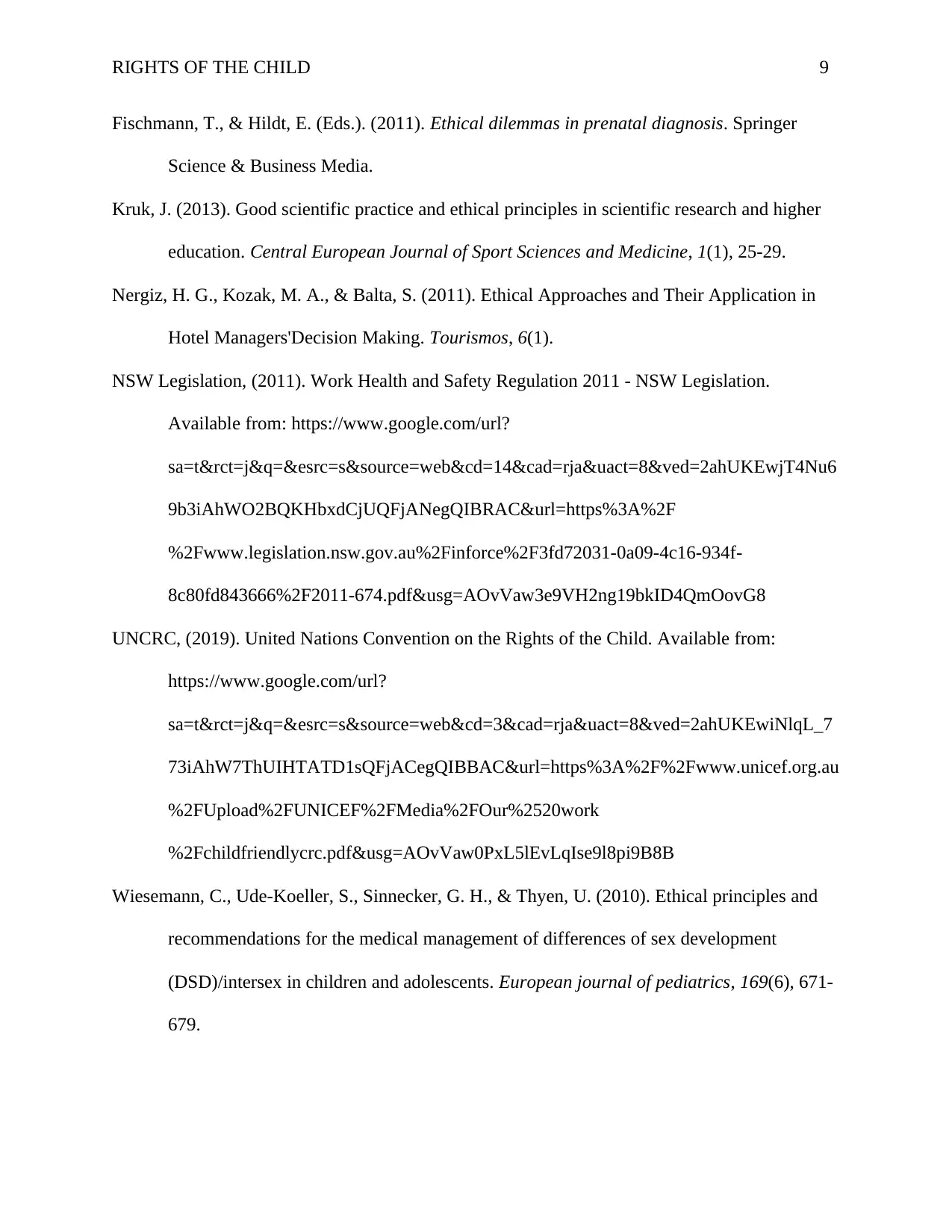
RIGHTS OF THE CHILD 9
Fischmann, T., & Hildt, E. (Eds.). (2011). Ethical dilemmas in prenatal diagnosis. Springer
Science & Business Media.
Kruk, J. (2013). Good scientific practice and ethical principles in scientific research and higher
education. Central European Journal of Sport Sciences and Medicine, 1(1), 25-29.
Nergiz, H. G., Kozak, M. A., & Balta, S. (2011). Ethical Approaches and Their Application in
Hotel Managers'Decision Making. Tourismos, 6(1).
NSW Legislation, (2011). Work Health and Safety Regulation 2011 - NSW Legislation.
Available from: https://www.google.com/url?
sa=t&rct=j&q=&esrc=s&source=web&cd=14&cad=rja&uact=8&ved=2ahUKEwjT4Nu6
9b3iAhWO2BQKHbxdCjUQFjANegQIBRAC&url=https%3A%2F
%2Fwww.legislation.nsw.gov.au%2Finforce%2F3fd72031-0a09-4c16-934f-
8c80fd843666%2F2011-674.pdf&usg=AOvVaw3e9VH2ng19bkID4QmOovG8
UNCRC, (2019). United Nations Convention on the Rights of the Child. Available from:
https://www.google.com/url?
sa=t&rct=j&q=&esrc=s&source=web&cd=3&cad=rja&uact=8&ved=2ahUKEwiNlqL_7
73iAhW7ThUIHTATD1sQFjACegQIBBAC&url=https%3A%2F%2Fwww.unicef.org.au
%2FUpload%2FUNICEF%2FMedia%2FOur%2520work
%2Fchildfriendlycrc.pdf&usg=AOvVaw0PxL5lEvLqIse9l8pi9B8B
Wiesemann, C., Ude-Koeller, S., Sinnecker, G. H., & Thyen, U. (2010). Ethical principles and
recommendations for the medical management of differences of sex development
(DSD)/intersex in children and adolescents. European journal of pediatrics, 169(6), 671-
679.
Fischmann, T., & Hildt, E. (Eds.). (2011). Ethical dilemmas in prenatal diagnosis. Springer
Science & Business Media.
Kruk, J. (2013). Good scientific practice and ethical principles in scientific research and higher
education. Central European Journal of Sport Sciences and Medicine, 1(1), 25-29.
Nergiz, H. G., Kozak, M. A., & Balta, S. (2011). Ethical Approaches and Their Application in
Hotel Managers'Decision Making. Tourismos, 6(1).
NSW Legislation, (2011). Work Health and Safety Regulation 2011 - NSW Legislation.
Available from: https://www.google.com/url?
sa=t&rct=j&q=&esrc=s&source=web&cd=14&cad=rja&uact=8&ved=2ahUKEwjT4Nu6
9b3iAhWO2BQKHbxdCjUQFjANegQIBRAC&url=https%3A%2F
%2Fwww.legislation.nsw.gov.au%2Finforce%2F3fd72031-0a09-4c16-934f-
8c80fd843666%2F2011-674.pdf&usg=AOvVaw3e9VH2ng19bkID4QmOovG8
UNCRC, (2019). United Nations Convention on the Rights of the Child. Available from:
https://www.google.com/url?
sa=t&rct=j&q=&esrc=s&source=web&cd=3&cad=rja&uact=8&ved=2ahUKEwiNlqL_7
73iAhW7ThUIHTATD1sQFjACegQIBBAC&url=https%3A%2F%2Fwww.unicef.org.au
%2FUpload%2FUNICEF%2FMedia%2FOur%2520work
%2Fchildfriendlycrc.pdf&usg=AOvVaw0PxL5lEvLqIse9l8pi9B8B
Wiesemann, C., Ude-Koeller, S., Sinnecker, G. H., & Thyen, U. (2010). Ethical principles and
recommendations for the medical management of differences of sex development
(DSD)/intersex in children and adolescents. European journal of pediatrics, 169(6), 671-
679.
⊘ This is a preview!⊘
Do you want full access?
Subscribe today to unlock all pages.

Trusted by 1+ million students worldwide
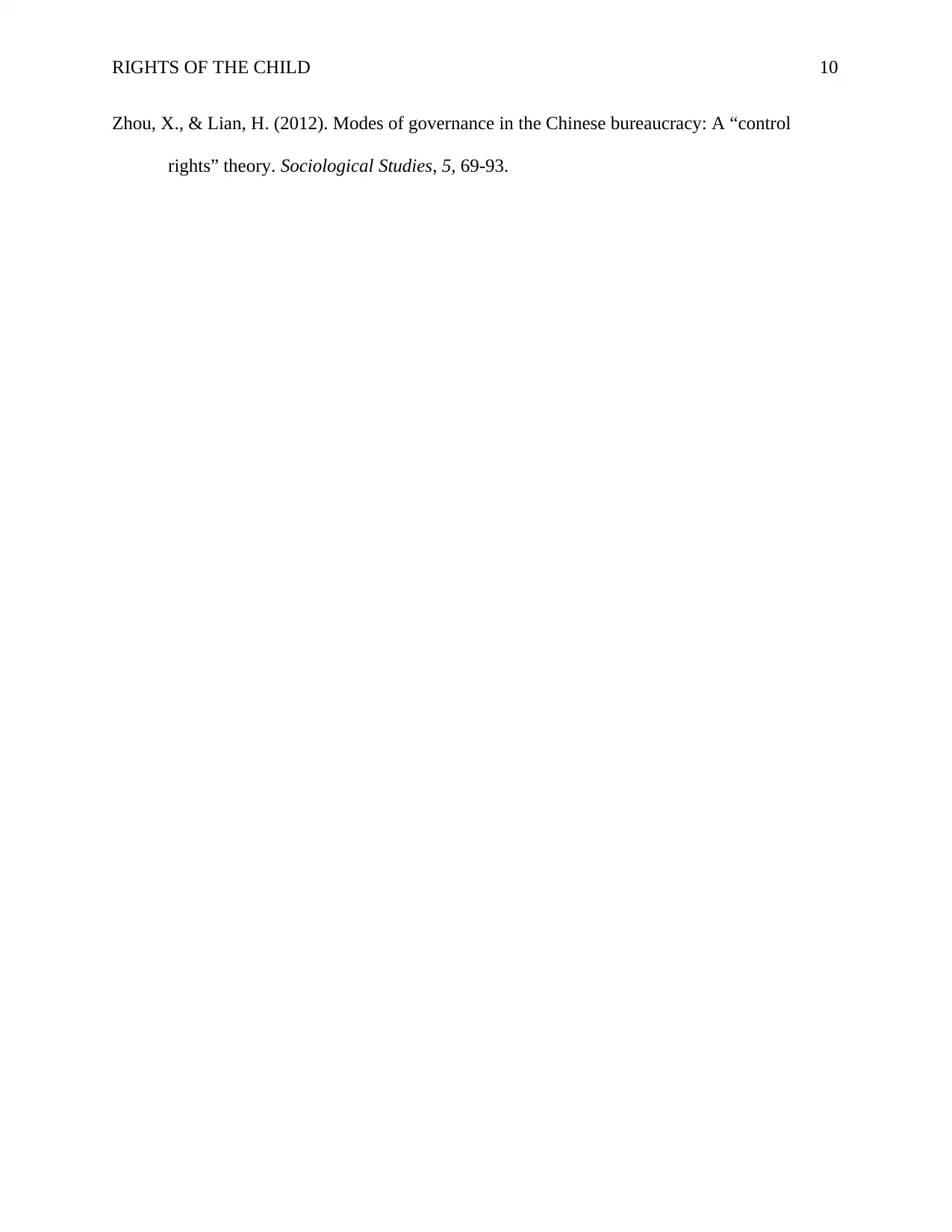
RIGHTS OF THE CHILD 10
Zhou, X., & Lian, H. (2012). Modes of governance in the Chinese bureaucracy: A “control
rights” theory. Sociological Studies, 5, 69-93.
Zhou, X., & Lian, H. (2012). Modes of governance in the Chinese bureaucracy: A “control
rights” theory. Sociological Studies, 5, 69-93.
1 out of 10
Related Documents
Your All-in-One AI-Powered Toolkit for Academic Success.
+13062052269
info@desklib.com
Available 24*7 on WhatsApp / Email
![[object Object]](/_next/static/media/star-bottom.7253800d.svg)
Unlock your academic potential
Copyright © 2020–2025 A2Z Services. All Rights Reserved. Developed and managed by ZUCOL.





